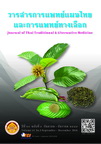Antifungal activity of ethanolic extracts from the rhizomes of Zingiberaceae plants
Main Article Content
Abstract
Rationale and Objective: Dermatophytosis is fungal infections of the skin caused by dermatophytes and can be treated with currently available antifungal. Moreover, the infections can be cured with medicinal plants by topical applying on the infected area. In Thai folk medicine, many plants have been claimed for the treatment of dermatitis. However, some plants still lack the scientific data for supporting the effectiveness of treatment. The objective of this study was to investigate antifungal activities of ethanolic extracts from the rhizome of plants in the Zingiberaceae family.
Methodology: The ethanolic rhizome extracts of fifteen Zingiberaceae species were tested for antifungal activities against Candida albicans and three dermatophytes i.e. Trichophyton rubrum, Trichophyton mentagrophytes and Microsporum gypseum using broth microdilution assay.
Results: Amongst fifteen extracts, the rhizomes of Curcuma amada Roxb. and Zingiber ottensii Valeton exhibited the most potent antifungal activities against both yeast and dermatophytes with Minimum Inhibitory Concentration (MIC) values of less than 50 and 6.25 µg/mL, respectively. They showed the Minimum Fungicidal Concentration (MFC) values of 100 µg/mL to C. albicans and 3.13 - 6.25 µg/mL to T. rubrum, T. mentagrophytes, and M. gypseum.
Discussion and Conclusion: The rhizomes of C. amada and Z. ottensii showed potent antifungal activities and could kill all tested fungi. Therefore, both plants might be promising sources for isolation of antifungal substances and utilization for development of antifungal drugs from medicinal plants in further study.
Article Details
References
2. Nenoff P, KrÜger C, Schaller J, Ginter-Hanselmayer G, Schulte-Beerbunl R, Tietz HJ. Mycology- an update part 2: dermatomycoses: clinical picture and diagnostics. J Dtsch Dermatol Ges. 2014;12(9):749-77.
3. Gupta AK, Ryder JE, Chow M, Cooper EA. Dermatophytosis; the management of fungal infections. Skinmed. 2005;4(5):305-10.
4. Degreef HJ, DeDoncker PR. Current therapy of dermatophytosis. J Am Acad Dermatol. 1994;31:S25-30.
5. สมุนไพรอภัยภูเบศร. สมุนไพรต้านเชื้อรา ปัญหากวนใจยามฝนพรำ. [Internet]. 2555 สิงหาคม. [2558 สิงหาคม 12]. ที่มา: http://www.abhaiherb.com/knowledge/thaiherb/1366
6. Singh G, Kapoor IP, Singh P, de Heluani CS, de Lampasona MP, Catalan CA. Chemistry, antioxidant and antimicrobial investigation on essential oil and oleoresins of Zingiber officinale. Food Chem Toxicol. 2008;46(10):3295-302.
7. Azizi A, Aghayan S, Zaker S, Shakeri M, Entezari N, Lawaf S. In vitro effect of Zingiber officinale extract on growth of Streptococcus mutans and Streptococcus sanguinis. Int J Dent. 2015;2015:489842. Doi: 10.1155/2015/489842. PubMed PMID: 26347778
8. Chudiwal AK, Jain DP, Somani RS. Alpenia galangal Willd.- An overview on phyto-pharmacological properties. IJNPR. 2010;1(2):143-9.
9. Singh R, Chandra R, Bose M, Luthra PM. Antibacterial activity of Curcuma longa rhizome extract on pathogenic bacteria. Curr Sci. 2002;83(6):737-40.
10. Wuthi-udomlert M, Grisanapan W, Luanratana O, Caichompoo W. Antifungal activity of Curcuma longa grown in Thailand. Southeast Asian J Trop Med Public Health. 2000;31:178-82.
11. Apisariyakul A, Vanittanakom N, Buddhasukh D. Antifungal activity of turmeric oil extracted from Curcuma longa (Zingiberaceae). J Ethnopharmacol. 1995;49(3):163-9.
12. Polgar PE. National Committee for Clinical Laboratory Standards. Reference method for broth dilution antifungal susceptibility testing of yeasts; approved standard. 2nd ed: NCCLS Document M27-A2; 2002. 31 p.
13. The Clinical and Laboratory Standard Institute. Reference method for broth dilution antifungal susceptibility testing of filamentous fungi; approved standard. 2nd ed: CLSI Document M38-A2; 2008. 13 p.
14. Sirirugsa P. Thai Zingiberaceae: species diversity and their uses. Pure Appl Chem. 1998;70(11):1-8.
15. Norajit K, Laohakunjit N, Kerdchoechuen O. Antibacterial effect of five Zingiberaceae essential oils. Molecules. 2007;12(8):2047-60.
16. Habsah M, Amran M, Mackeen MM, Lajis NH, Kikuzaki H, Nakatani N, et al. Screening of Zingiberaceae extracts for antimicrobial and antioxidant activities. J Ethnopharmacol. 2000;72(3):403-10.
17. Chen IN, Chang CC, NgCC, Wang CY, Shyu YT, Chang TL. Antioxidant and antimicrobial activity of Zingiberaceae plants in Taiwan. Plant Foods Hum Nutr. 2008;63:15-20.
18. Ficker CE, Smith ML, Susiarti S, Leaman DJ, Irawati C, Arnason JT. Inhibition of human pathogenic fungi by member of Zingiberaceae used by the Kenyah (Indonesian Borneo). J Ethnopharmacol. 2003;85(2-3):289-93.
19. Jantan IB, Yassin MSM, Chin CB, Chen LL, Sim NL. Antifungal activity of the essential oils of nine Zingiberaceae species. Pharm Biol. 2003;41(5):392-7.
20. Policegoudra RS, Aradhya SM, Singh L. Mango ginger (Curcuma amada Roxb.)- A promising spice for phytochemicals and biological activities. J Biosci. 2011;36:739-48.
21. Jatoi SA, Kikuchi A, Gilani SA, Watanabe KN. Phytochemical, pharmacological and ethnobotanical studies in mango ginger (Curcuma amada Roxb. : Zingiberaceae). Phytother Res. 2007;21:507-16.
22. คณะเภสัชศาสตร์ มหาวิทยาลัยมหิดล. สยามไภษัชยพฤกษ์: ภูมิปัญญาของชาติ. กรุงเทพฯ: อมรินทร์พริ้นติ้ง แอนด์ พับลิชชิ่ง จำกัด (มหาชน); 2539.

